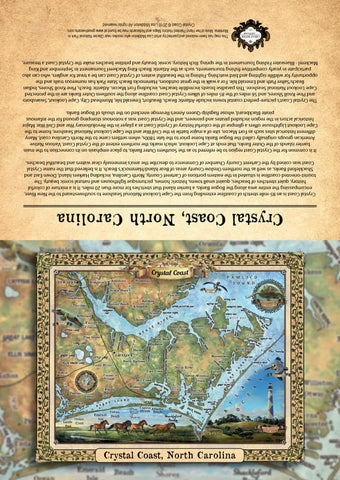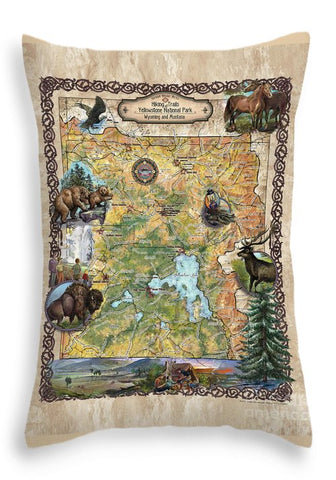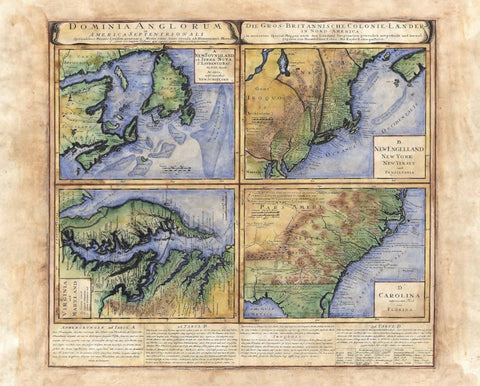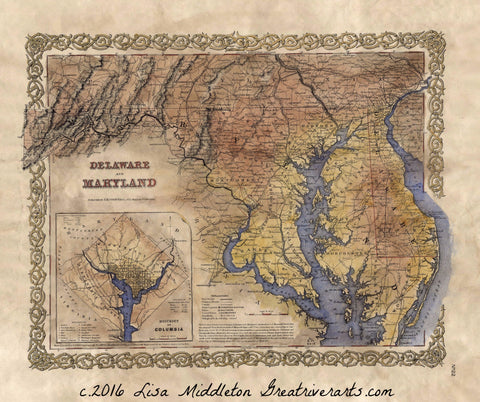54 Idaho Territory 11x14" vintage historic antique map poster print by Lisa Middleton
This map of Idaho features various rivers, lakes, mountains, and towns that were established throughout the area. It is a great overview map featuring general topography and established towns in the area. Furthermore, small portions of Washington, Oregon, Nevada, Utah, Wyoming, Montana, and Canada can also be viewed.
That year, Idaho made several significant accomplishments for herself. The completion of Barber Dam, the establishment of Coure D'Alene National Forest, and the small, but important, towns of Buhl and Rupert were established.
Hollingshead Homestead was also constructed by two brothers, Karl and Miles Hollingshead. They claimed the homestead land operating under the provisions set forth in the Homestead act of 1862. The Act encouraged settlers to cultivate portions of Eastern Idaho that were not productive due to the challenges with climate that discouraged habitation. At the time, the homestead was not seen as a significant establishment. It was merely two brothers building a cabin, granary, smokehouse, and horse barn. However, history would reflect a different story. The homestead was added to the National Register of Historic Places in 2006, spotlighting the importance the Homestead Act played in settling the eastern portion of the state.
However, even though Idaho is known for potatoes, easy to grow due to the volcanic soil and brisk summer nights, there are other crops just as imprtant to the potato state. In time, timber, livestock, and grain would become part of the state's main agricultural production. Cities would sprout up around areas of agricultural industry and cultivated land. One of these cities, in particular, highlights the diverse agricultural market that began to develop in Idaho at the turn of the century.
In 1906 the little town of Sugar City was incorporated. Chartered in 1903, the town was named after their most well-known agricultural product... sugar beets. In addition, the city had been planned to be developed in close proximity to the Utah and Idaho Sugar Company. That, coupled with the sugar beets dominating the farmland in the area, made Sugar City a likely moniker.
Over the next few years, agriculture would begin to develop as the Union Pacific Railroad would
continue to grow. The expansion of the railroad would eventually open up the state to national
agriculture and livestock markets. This would be of great benefit to Idaho. That is in fact why to this day, when people think of Idaho, they think of acres of farming and agriculture.
To order an 18x24" Signed and numbered UV resistant Giclee please copy and paste this address into your browser:
https://www.etsy.com/listing/166229895/18x24-large-maps-easy-to-frame-archaic?
To Order a 24x36" Signed and numbered UV resistand Giclee please copy and paste this address in to your browser: https://www.etsy.com/listing/172861207/large-24x36-giclee-reproduction-of-any?
To order the Hand Painted Original of this map please copy and paste this address into your browser: https://www.etsy.com/listing/172893547/large-masterpiece-historic-map-paintings?
"Due to the unique nature of our maps all sizes are approximate. Please do not purchase a frame until you receive the map and measure it. "Free Shipping on all orders!
Satisfaction Guarantee. Full refund if returned in original condition within 14 days. Buyer pays return shipping. Full refund if returned in original condition within 14 days. Buyer pays return shipping.
That year, Idaho made several significant accomplishments for herself. The completion of Barber Dam, the establishment of Coure D'Alene National Forest, and the small, but important, towns of Buhl and Rupert were established.
Hollingshead Homestead was also constructed by two brothers, Karl and Miles Hollingshead. They claimed the homestead land operating under the provisions set forth in the Homestead act of 1862. The Act encouraged settlers to cultivate portions of Eastern Idaho that were not productive due to the challenges with climate that discouraged habitation. At the time, the homestead was not seen as a significant establishment. It was merely two brothers building a cabin, granary, smokehouse, and horse barn. However, history would reflect a different story. The homestead was added to the National Register of Historic Places in 2006, spotlighting the importance the Homestead Act played in settling the eastern portion of the state.
However, even though Idaho is known for potatoes, easy to grow due to the volcanic soil and brisk summer nights, there are other crops just as imprtant to the potato state. In time, timber, livestock, and grain would become part of the state's main agricultural production. Cities would sprout up around areas of agricultural industry and cultivated land. One of these cities, in particular, highlights the diverse agricultural market that began to develop in Idaho at the turn of the century.
In 1906 the little town of Sugar City was incorporated. Chartered in 1903, the town was named after their most well-known agricultural product... sugar beets. In addition, the city had been planned to be developed in close proximity to the Utah and Idaho Sugar Company. That, coupled with the sugar beets dominating the farmland in the area, made Sugar City a likely moniker.
Over the next few years, agriculture would begin to develop as the Union Pacific Railroad would
continue to grow. The expansion of the railroad would eventually open up the state to national
agriculture and livestock markets. This would be of great benefit to Idaho. That is in fact why to this day, when people think of Idaho, they think of acres of farming and agriculture.
To order an 18x24" Signed and numbered UV resistant Giclee please copy and paste this address into your browser:
https://www.etsy.com/listing/166229895/18x24-large-maps-easy-to-frame-archaic?
To Order a 24x36" Signed and numbered UV resistand Giclee please copy and paste this address in to your browser: https://www.etsy.com/listing/172861207/large-24x36-giclee-reproduction-of-any?
To order the Hand Painted Original of this map please copy and paste this address into your browser: https://www.etsy.com/listing/172893547/large-masterpiece-historic-map-paintings?
"Due to the unique nature of our maps all sizes are approximate. Please do not purchase a frame until you receive the map and measure it. "Free Shipping on all orders!
Satisfaction Guarantee. Full refund if returned in original condition within 14 days. Buyer pays return shipping. Full refund if returned in original condition within 14 days. Buyer pays return shipping.
We Also Recommend











